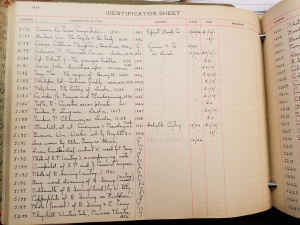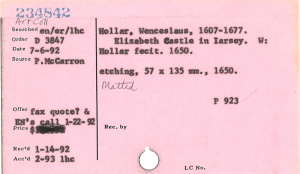Accession numbers: Difference between revisions
(→Six-digit accession numbers: Added caveat about 37xxxx to 48xxxx) |
m (→Six-digit accession numbers: re-worded) |
||
| Line 23: | Line 23: | ||
The six-digit series began July 9, 1948, with 125001 (because it was guessed the library already had about 125,000 things) but until 2004 the following material types instead received separate serial numbers: manuscripts (MS ADD), motion pictures (MP), video tapes (VCR), CDs (CD), CD-ROMs (CD-ROM), DVDs (DVD), phonograph records (p.r.), reel-to-reel tape recordings (t.r.), and cassette tape recordings (t.r.c.). When written on the item, the six-digit number is preceded by the letter "F" (for "Folger") to disambiguate it in case there are other numbers. The "F" is not considered part of the accession number, and is omitted when recording it elsewhere. | The six-digit series began July 9, 1948, with 125001 (because it was guessed the library already had about 125,000 things) but until 2004 the following material types instead received separate serial numbers: manuscripts (MS ADD), motion pictures (MP), video tapes (VCR), CDs (CD), CD-ROMs (CD-ROM), DVDs (DVD), phonograph records (p.r.), reel-to-reel tape recordings (t.r.), and cassette tape recordings (t.r.c.). When written on the item, the six-digit number is preceded by the letter "F" (for "Folger") to disambiguate it in case there are other numbers. The "F" is not considered part of the accession number, and is omitted when recording it elsewhere. | ||
Note that what appear to be six-digit serial numbers in the 37xxxx to 48xxxx range are actually date-based accession numbers | Note that what appear to be six-digit serial numbers in the 37xxxx to 48xxxx range are actually date-based accession numbers where the dots or hyphens separating yy-mm-dd were omitted. | ||
Accession slips numbered lower than about 200000 were often typed based only on the title page, without regard for completeness or additional information (e.g., a colophon). <ref>Memo from Curator of Books and Exhibitions, 14 April 1995.</ref> | Accession slips numbered lower than about 200000 were often typed based only on the title page, without regard for completeness or additional information (e.g., a colophon). <ref>Memo from Curator of Books and Exhibitions, 14 April 1995.</ref> | ||
Revision as of 09:12, 9 September 2021
Accession numbers are serial numbers assigned to collection material at the time it is formally added to the library's collection. The earliest accession numbers at the Folger are four digits. Currently, a six-digit serial number is used. Accession numbers were not used by Mr. and Mrs. Folger, though their case numbers serve a similar purpose, as do "temporary" ART Inv. numbers.
At the Folger, accession numbers are usually referred to as "acc" numbers (pronounced "ack"), a short form that sounds the same as "acq" (short for acquisitions, e.g. "Acq Night" and "the Acq Department"). Material is acquired when it becomes Folger property through gift, purchase, exchange, etc.; appropriate material is then accessioned (assigned the next accession number in sequence and added to the collection).
Four-digit accession numbers
This series begins with item number 3001 (October 20, 1930) and runs through item number 7029 (August 31, 1938). The numbering of blank lines continues through 7049, at the bottom of the page, along with the note "On September 27, 1938, the keeping of the accession book was discontinued by order of the Director, Dr. Joseph Q. Adams" signed "Roberta Harrison, Secretary in Charge of Accessions." No reason is given in the book, but perhaps this was a time-saving measure related to the purchase of the Harmsworth Collection that year.
Numbering presumably began at 3001 to distinguish accession numbers from case numbers, which only went up to the 2000s.
The numbers are recorded by hand in an unlabeled green binder[1] on pre-printed loose-leaf "Identification Sheets." Each entry gives a brief description of the item, its source ("G" for "gift" or a purchase order number, followed by a name), a date (apparently the date the item was received), the cost, and remarks, if any.
Henry N. Paul's gifts on September 3, 1937 (nos. 5921 through 6176) and June 6, 1938 (nos. 6735-6858) are the two largest single-source entries by far. There are also at least two entries for small batches from Paul: June 6, 1936 (nos. 4593-4596), and June 27, 1938 (nos. 6897 through 6900).
Date-based accession numbers
More information to come. This style of accession number is known to have existed between September 1937 and June 1948. Apparently based on date of acquisition or of processing with two-digit year, and a serial number by day, but sometimes yy-mm-dd and sometimes mm-dd-yy preceding the serial number. Unfortunately, the dots or hyphens dividing yy.mm.dd were often dropped when the cards were re-keyed into the online catalog, so what appear to be six-digit serial numbers are actually date-based accession numbers when they fall in the 37xxxx to 48xxxx range.
Format-based accession numbers
More information to come. Serial numbers based on order of accession, in separate series by format: MS Add, VCR, m.p., etc. until 2004, when six-digit numbers began to be used regardless of format.
Six-digit accession numbers
The six-digit series began July 9, 1948, with 125001 (because it was guessed the library already had about 125,000 things) but until 2004 the following material types instead received separate serial numbers: manuscripts (MS ADD), motion pictures (MP), video tapes (VCR), CDs (CD), CD-ROMs (CD-ROM), DVDs (DVD), phonograph records (p.r.), reel-to-reel tape recordings (t.r.), and cassette tape recordings (t.r.c.). When written on the item, the six-digit number is preceded by the letter "F" (for "Folger") to disambiguate it in case there are other numbers. The "F" is not considered part of the accession number, and is omitted when recording it elsewhere.
Note that what appear to be six-digit serial numbers in the 37xxxx to 48xxxx range are actually date-based accession numbers where the dots or hyphens separating yy-mm-dd were omitted.
Accession slips numbered lower than about 200000 were often typed based only on the title page, without regard for completeness or additional information (e.g., a colophon). [2]
Six-digit accession numbers for sammelbands represent the physical object as a whole, not a specific item within it (which are referred to as item 1, item 2, item 3, etc. of that accession number). Until approximately 2015, individual titles within the volume did get unique accession numbers in the form of the six digits, a decimal point, then 1, 2, 3, etc. In most cases, .1 is the first title in the volume, .2 is the second, and so on. However there are early accession numbers (lower than about 200000?) where only the titles not already in the collection received an accession number and typed accession slip.[3] There are also examples where the decimal points assigned in acquisitions did not correspond to the number of bibliographic 'units' in the volume for cataloging purposes (e.g., where what looks like a "part 2" at first glance is actually a separate publication, or vice versa).
There are gaps in the numbering thanks to numbers kept in reserve not being needed (e.g. 245001-245999 were reserved for the Massey collection, but only 245001-245326 were needed; the rest of the numbers remain unused, except for 245901 and 245902, which were assigned to non-Massey STC fragments by accident).
These groups of six-digit numbers are known to be not unique:
- 156481-156509 were used twice: second series has "[2d]" after the number.
- 207168-207226 were used twice: vault books have just the number, modern books have the number followed by "[2d]".
- 222701-222744 were used twice: second series has "[2d]" after the number (222701-222800 were reserved for the Colt collection, but there turned out to be more books than expected, so they re-used the first 44 numbers rather than jumping ahead to the next available number).
- 226884-226893 were used twice: vault books have just the number, modern books have the number followed by "a".
- Note: accession slips are filed in two series; books on the shelf are interfiled.
Until 2002 all Mazarinades received accession no. 134829 and all Knuttels received accession number 143966.
Some open-stacks books no longer receive accession numbers (as of 2009?). E.g., YBP books with vendor-supplied cataloging and processing are considered "shelf ready."
Accession numbers that indicate former owners
| Accession number range | Former owner |
|---|---|
| 4593-4596 | Henry N. Paul |
| 5921-6176 | Henry N. Paul |
| 6735-6858 | Henry N. Paul |
| 6897-6900 | Henry N. Paul |
| 131500-131595 | Bridgewater |
| 131968-132743 | Harmsworth |
| 132828-133891 | Harmsworth |
| 133892-134394 | Shipdham Church |
| 134395-134456 | Harmsworth |
| 134457-134483 | Shipdham Church |
| 134484-134500 | Harmsworth |
| 134501-134514 | Shipdham Church |
| 134516-134520 | Harmsworth |
| 134521-134530 | Shipdham Church |
| 136518-136640 | California University at Los Angeles William A. Clark Library |
| 136869-137241 | Huntington |
| 137401-137998 | McAlpin |
| 139067-139080 | McAlpin |
| 148001-150305 | Sir Thomas Phillips |
| 171014-171259 | Sir Thomas Phillips |
| 191601-191888 | Cashel Cathedral Library |
- Note: McAlpin duplicates were disposed of, and include the following numbers:
- 137452, 137459, 137462, 137466, 137483, 137494, 137505, 137528, 137567, 137566, 137600, 137631, 137679, 137691, 137700, 137711, 137778, 137875
Accession numbers in Folger MARC records
The Folger started creating MARC records in the 1980s (in RLIN, to be printed out on cards), and in the years since, accession numbers have ended up in various fields and subfields. This is an attempt to list them all. Please add to the list as you discover them.
Important: numbers in these fields are not necessarily accession numbers.
- Note: some 6-digit accession numbers are prefaced with "ac" or "F"; if you come across such a thing when editing a Hamnet record, delete the preface. Do not delete the "cs" that precedes case numbers.
- 050‡f
- 090‡f
- 099‡a
- 099‡f
- 541‡e (current practice)
- 852‡h (not really an accession number: catalogers construct "accession-based" call numbers" in the ‡h, converting the accession number to a call number by adding "hyphen space" in the middle, and a lowercase letter for shelving type at the end; sometimes "space hyphen" or just "hyphen" or "space hyphen space" was added instead, but these have since been normalized in the holdings record).
- 852‡j (discontinued in 2017: all 852‡j numbers in holdings records were moved by machine to a 541‡e; 852‡j in Bib records left untouched because they're only there to provide keyword searchability, and there's no automatic way to indicate which 541 goes with which book when there are multiple copies).
- 852‡x (as the first part of a non-displaying local note)
- 852‡z (as the first part of the local note)
- 876‡z (as the first part of the local note; as of August 2017 will only be found in bib records: all holdings 876s were converted to 852s)
- 950‡q
- 955‡q

